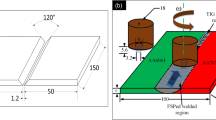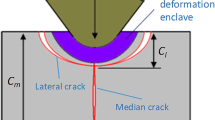Abstract
Ultrasonic vibration-assisted micro-end grinding (UAMEG) is a promising processing method for micro-parts made of hard and brittle materials. Grinding force is one of the most important parameters which can synthetically reflect the grinding process. So, it is a key issue to establish a model for the reliable prediction of grinding force in UAMEG. First, by studying removal mechanism and the micro-topography of grinding surface, the micro-end grinding zone is divided into the following three grinding regions: main grinding region, plowing grinding region, and sliding grinding region. Then, the single-grain force model is developed under different material removal modes, and the grinding force model of the whole grinding wheel is established considering size effect. To verify the correctness of the proposed model, contrast grinding tests of silica glass with and without ultrasonic assistance using micro-radial electroplated diamond wheel are conducted. The theoretical predicted values of grinding force match well with the experimental results. The grinding forces are significantly reduced, and ductile machining is easier to be achieved.
Similar content being viewed by others
References
Zhong ZW, Venkatesh VC (2009) Recent developments in grinding of advanced materials. Int J Adv Manuf Technol 41:468–480
Sreejith PS, Ngoi BKA (2001) Material removal mechanisms in precision machining of new materials. Int J Mach Tools Manuf 41:1831–1843
Liu K, Li XP, Liang SY (2007) The mechanism of ductile chip formation in cutting of brittle materials. Int J Adv Manuf Technol 33:875–884
Ramesh K, Huang H, Yin L, Zhao J (2004) Microgrinding of deep micro grooves with high table reversal speed. Int J Mach Tools Manuf 44:39–49
Perveen A, Jahan MP, Rahman M, Wong YS (2012) A study on microgrinding of brittle and difficult-to-cut glasses using on-machine fabricated poly crystalline diamond (PCD) tool. J Mater Process Technol 212:580–593
Dornfeld D, Min S, Takeuchi Y (2006) Recent advances in mechanical micromachining. CIRP Ann Manuf Technol 55:745–768
Feng J, Kim BS, Shih A, Ni J (2009) Tool wear monitoring for micro-end grinding of ceramic materials. J Mater Process Technol 209:5110–5116
Akbari J, Borzoie H, Mamduhi MH (2008) Study on ultrasonic vibration effects on grinding process of alumina ceramic (Al2O3). World Acad Sci Eng Technol 41:785–789
Tawakoli T, Azarhoushang B, Rabiey M (2009) Ultrasonic assisted dry grinding of 42CrMo4. Int J Adv Manuf Technol 42:883–891
Chen HF, Tang JY, Zhou W (2013) An experimental study of the effects of ultrasonic vibration on grinding surface roughness of C45 carbon steel. Int J Adv Manuf Technol 68:2095–2098
Yan YY, Zhao B, Liu JL (2009) Ultraprecision surface finishing of nano-ZrO2 ceramics using two-dimensional ultrasonic assisted grinding. Int J Adv Manuf Technol 43(5–6):462–467
Wang Y, Lin B, Wang SL, Cao XY (2014) Study on the system matching of ultrasonic vibration assisted grinding for hard and brittle materials processing. Int J Mach Tools Manuf 77:66–73
Zhang JH, Zhao Y, Zhang S, Wei Z (2014) Kinematic analysis of ultrasonic vibration assisted micro end grinding. Key Eng Mater 609:1357–1361
Zhang JH, Zhao Y, Zhang S, Tian FQ, Guo LS, Dai RZ (2014) Study on effect of ultrasonic vibration on grinding force and surface quality in ultrasonic assisted micro end grinding of silica glass. Shock Vib 2014:1–10
Hecker R, Ramoneda I, Liang S (2003) Analysis of wheel topography and grit force for grinding process modelling. J Mater Process Technol 5:13–23
Park HW, Liang SY (2008) Force modeling of micro-grinding incorporating crystallographic effects. Int J Mach Tools Manuf 48:1658–1667
Chang H, Wang J (2008) A stochastic grinding force model considering random grit distribution. Int J Mach Tools Manuf 48:1335–1344
Durgumahanti US, Singh V, Rao PV (2010) A new model for grinding force prediction and analysis. Int J Mach Tools Manuf 50:231–240
Agarwal S, Rao PV (2013) Predictive modelling of force and power based on a new analytical undeformed chip thickness model in ceramic grinding. Int J Mach Tools Manuf 65:68–78
Cheng J, Gong YD (2014) Experimental study of surface generation and force modeling in micro-grinding of single crystal silicon considering crystallographic effects. Int J Mach Tools Manuf 77:1–15
Marshall DB, Lawn BR (1986) Indentation of brittle materials, microindentation techniques in materials science and engineering. ASTM STP 889:26–46
Lawn BR, Marshall DB (1979) Hardness, toughness, and brittleness: an indentation analysis. J Am Ceram Soc 62:347–350
Arif M, Rahman M, San WY (2011) Analytical model to determine the critical feed per edge for ductile–brittle transition in milling process of brittle materials. Int J Mach Tools Manuf 51:170–181
Bolshakov APGM (1998) Influences of pileup on the measurement of mechanical properties by load and depth sensing indentation techniques. J Mater Res 13:1049–1058
Malekian M, Mostofa MG, Park SS, Jun MBG (2012) Modeling of minimum uncut chip thickness in micro machining of aluminum. J Mater Process Technol 212:553–559
Hill R, Storakers B, Zdunek AB (1989) A theoretical study of the Brinell hardness test. Proc R Soc Lond A Mater 423:301–330
Taljat B, Pharr GM (2004) Development of pile-up during spherical indentation of elastic–plastic solids. Int J Solids Struct 41:3891–3904
Norbury AL, Samuel T (1928) The recovery and sinking-in or piling-up of material in the Brinell test, and the effects of these factors on the correlation of the Brinell with certain other hardness tests. J Iron Steel Res Int 117:673–687
Peng Z, Gong J, Miao H (2004) On the description of indentation size effect in hardness testing for ceramics: analysis of the nanoindentation data. J Eur Ceram Soc 24:2193–2201
Gauthier C, Lafaye S, Schirrer R (2001) Elastic recovery of a scratch in a polymeric surface: experiments and analysis. Tribol Int 34:469–479
Arcona C, Dow TA (1998) An empirical tool force model for precision machining. J Manuf Sci E-T Asme 120:700–707
Perveen A, Rahman M, Wong YS (2014) Modeling and simulation of cutting forces generated during vertical micro-grinding. Int J Adv Manuf Technol 71:1539–1548
Park HW (2008) Development of micro-grinding mechanics and machine tools. Georgia Institute of Technology, Atlanta
Lai XM, Li HT, Li CF, Lin ZQ, Ni J (2008) Modelling and analysis of micro scale milling considering size effect, micro cutter edge radius and minimum chip thickness. Int J Mach Tools Manuf 48:1–14
Josh SS, Melkote SN (2004) An explanation for the size-effect in machining using strain gradient plasticity. J Manuf Sci E-T Asme 126:679–684
KC J (2004) Mechanism of the chip formation and cutting dynamic of the micro scale milling process. University of Michigan, Michigan
Oxley PLB, Young HT (1989) The mechanics of machining: an analytical approach to assessing machinability. Ellis Horwood Publisher, London, pp. 136–182
Hecker RL (2002) Part surface roughness modeling and process optimal control of cylindrical grinding. Georgia Institute of Technology, Atlanta
Author information
Authors and Affiliations
Corresponding author
Rights and permissions
About this article
Cite this article
Jianhua, Z., Hui, L., Minglu, Z. et al. Study on force modeling considering size effect in ultrasonic-assisted micro-end grinding of silica glass and Al2O3 ceramic. Int J Adv Manuf Technol 89, 1173–1192 (2017). https://doi.org/10.1007/s00170-016-9148-5
Received:
Accepted:
Published:
Issue Date:
DOI: https://doi.org/10.1007/s00170-016-9148-5




